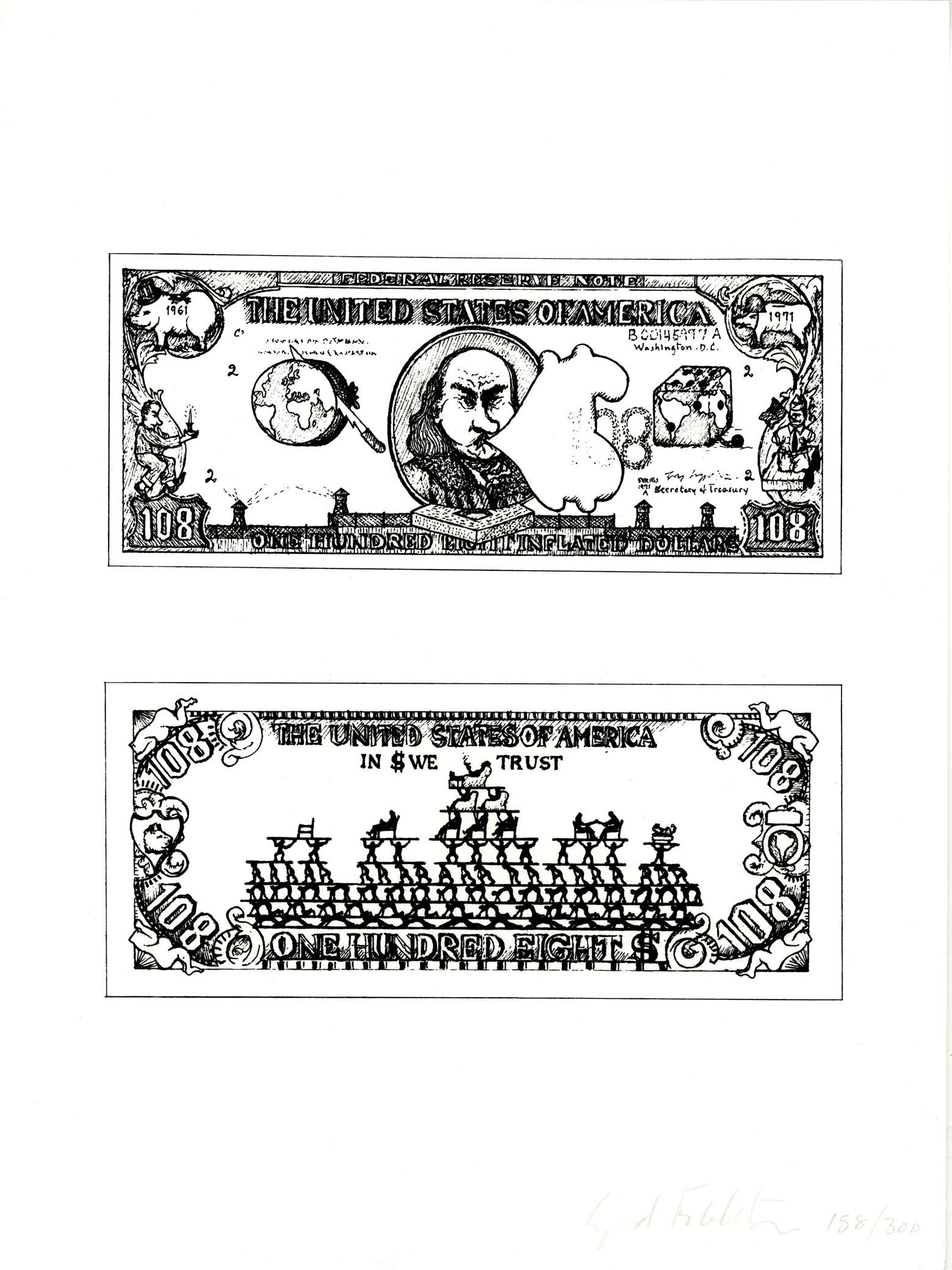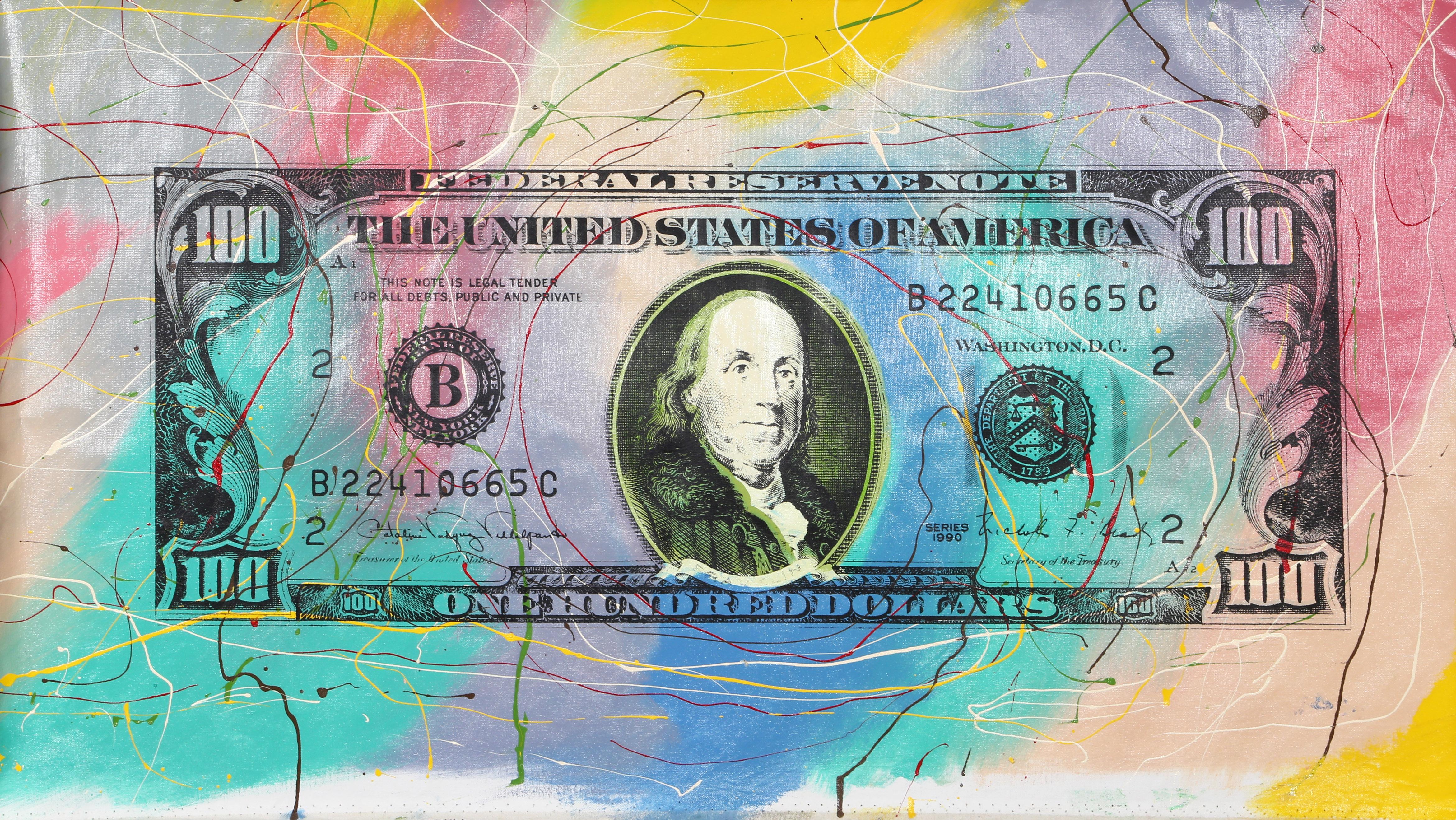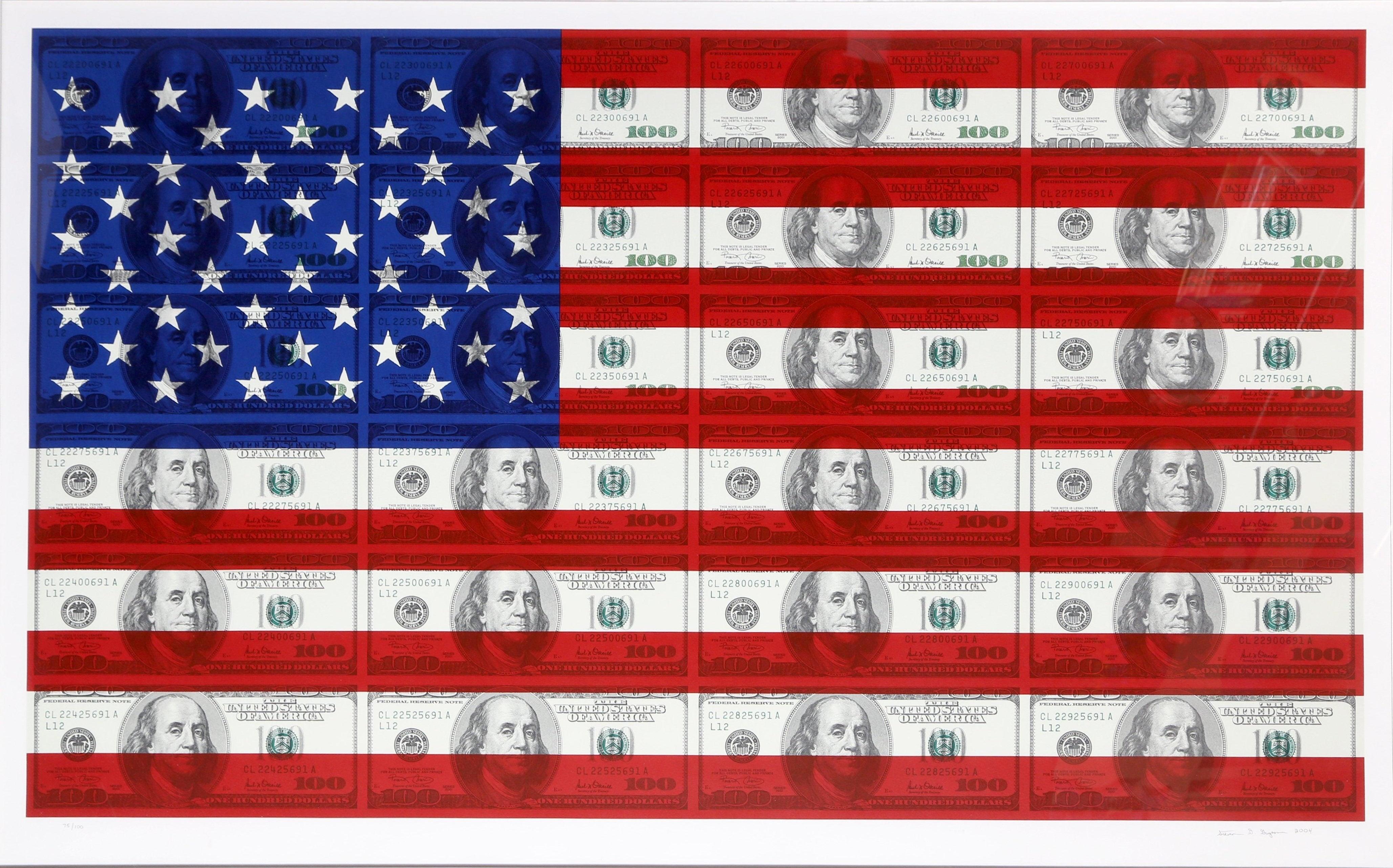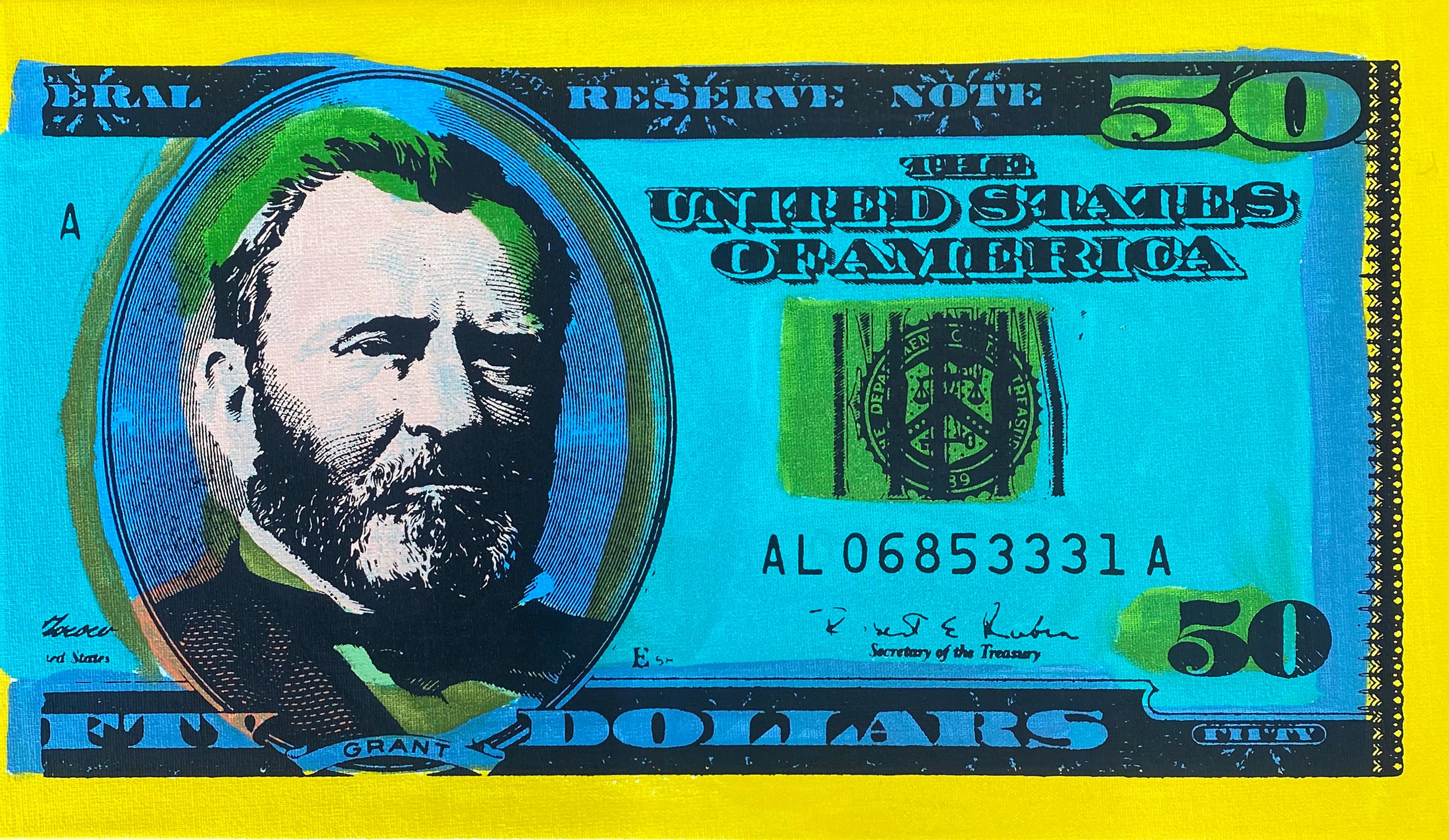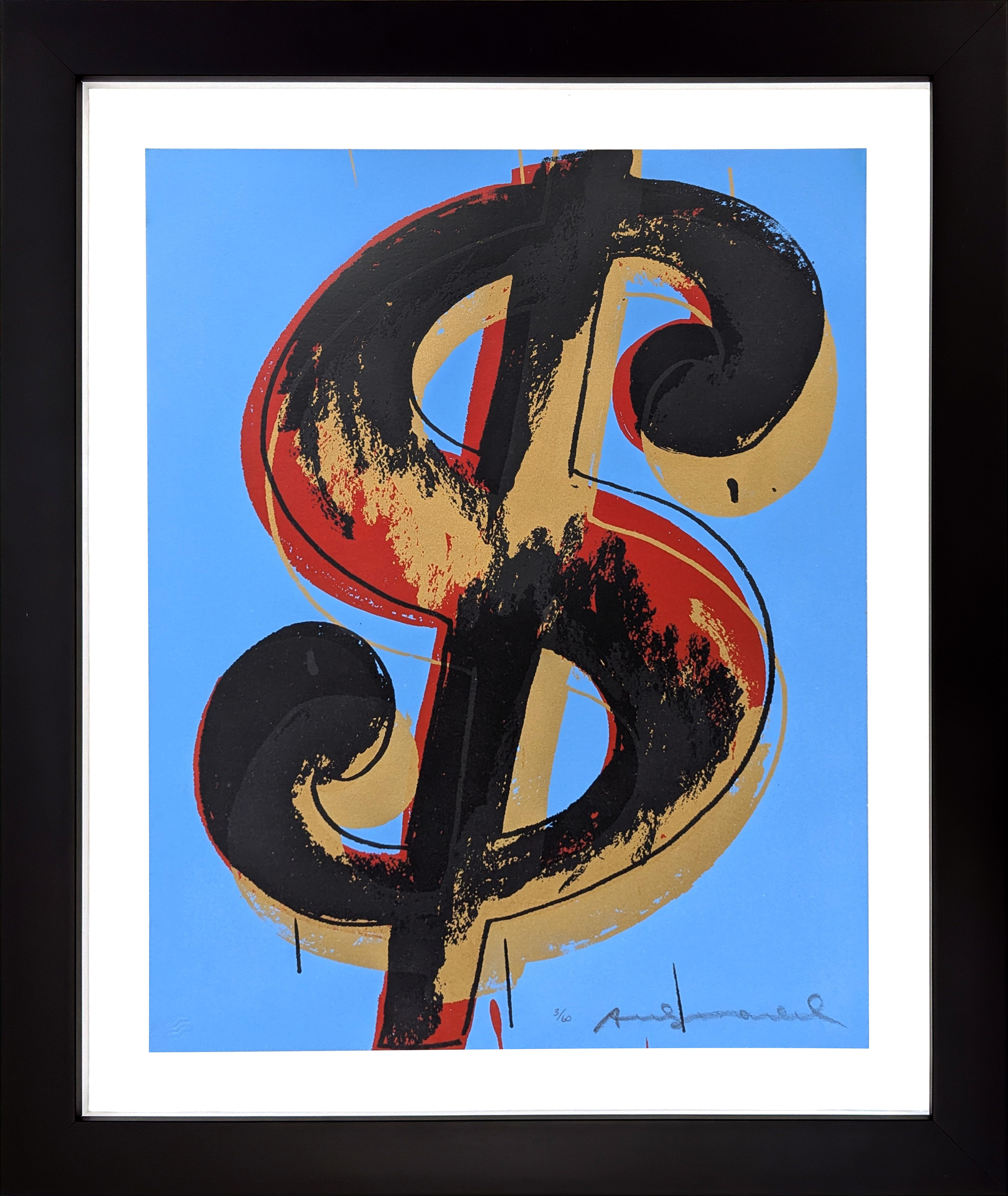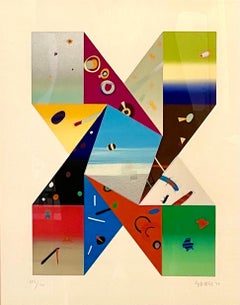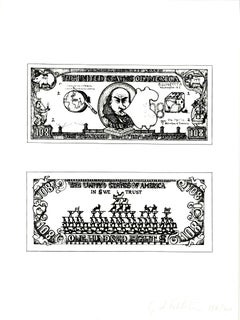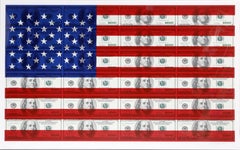Items Similar to 1960's Pop Art Silkscreen Print 108$ Bill Inflation Hand Signed and Numbered
Want more images or videos?
Request additional images or videos from the seller
1 of 6
Oyvind Fahlstrom1960's Pop Art Silkscreen Print 108$ Bill Inflation Hand Signed and Numbered1973
1973
$2,000
£1,484.89
€1,730.31
CA$2,776.65
A$3,105.85
CHF 1,616.30
MX$38,234.11
NOK 20,562.74
SEK 19,291.90
DKK 12,909.84
Shipping
Retrieving quote...The 1stDibs Promise:
Authenticity Guarantee,
Money-Back Guarantee,
24-Hour Cancellation
About the Item
Öyvind Axel Christian Fahlström (1928–1976) was a Swedish Multimedia artist.
Fahlström was born in Sao Paulo, Brazil, In July 1939 he was sent to Stockholm to visit some distant relatives and after World War II he started to study and later on to work as a writer, critic and journalist. From 1960 until 1976 he was married to the Swedish Pop Art painter Barbro Östlihn.
In 1953 Fahlström had his first solo exhibition, showing the drawing Opera, a room-sized felt-pen drawing. Also in 1953 he wrote Hätila ragulpr på fåtskliaben, a manifesto for concrete poetry, published in Swedish the following year and in English translation (by Mary Ellen Solt, in her anthology "Concrete Poetry. A world view") in 1968.
In 1956 Fahlström moved to Paris and lived there for three years before he moved to Front Street studio, New York City. In New York he worked with different artists and explored his role as an artist further. In 1962 he participated in the New Realists exhibition at the Sidney Janis Gallery, in New York City. His work was included in the 1964 Venice Biennale and he had a solo exhibition at Cordier & Ekstrom Inc., New York. In 1965 he joined the Sidney Janis Gallery.
In 1966 his work Performance of Kisses Sweeter Than Wine was included in 9 Evenings: Theatre and Engineering, organized by Experiments in Art and Technology at the 26th Street Armory, New York. The same year his painting in oil on photo paper was included in a group exhibition called Erotic Art at the Sidney Janis Gallery. Fahlström had solo exhibitions at the Sidney Janis Gallery in New York City in 1967, 1969, 1973 and 1976. In 1973 he wrote a play called The Black Room, based on the Watergate scandal, and he had a retrospective at Moore College of Art Gallery, in Philadelphia, Pa.
Fahlström's work is in the collection of the Museum of Modern Art, MoMA NY
Although some critics such as Frances Richard dismissed him as a "throwback to Surrealism or Agitprop at worst" other critics, such as Mary Flanagan have seen his use of games as constituting examples of critical play. On Swedish television he made a name for himself after he smoked a pipe that he claimed contained hashish during a national broadcast. This is from the portfolio
Various Artists, The New York Collection for Stockholm, 1973 with Lee Bontecou, John Chamberlain, Mark di Suvero, Jim Dine, Öyvind Fahlström, Dan Flavin, Red Grooms, Donald Judd, Ellsworth Kelly, Roy Lichtenstein, Sol LeWitt, Robert Morris, Louise Nevelson, Kenneth Noland, Claes Oldenburg, Nam June Paik, Robert Rauschenberg, James Rosenquist, George Segal, Richard Serra, Keith Sonnier, Richard Stankiewicz, Cy Twombly and Andy Warhol
Selected exhibitions
2006 Eye on Europe, Museum of Modern Art, New York City
2005 Art and Politics, Museum Morsbroich, Leverkusen Germany
2004 Galerie Air de Paris, Paris
2004 Galerie Johann König, Berlin
2003 Museum Het Domein, Sittard, Netherlands
2002 Institut d´art contemporain, Lyon-Villeurbanne, France
2002 Baltic, Centre for Contemporary Art, Gateshead, UK
2001/0 BAWAG Foundation, Vienna
2000 Museu d´Art Contemporani de Barcelona, Barcelona
1999 Gallery 400, University of Illinois, Chicago
1999 Norrköpings Konstmuseum, Norrköping, Sweden
1996 Centro Studi sull´arte Licia e Carlo Ludovico Ragghianti, Lucca, Italy
1996 Galerie Aurel Scheibler, Cologne
1996 Massachusetts Museum of Contemporary Art, North Adams, Massachusetts
1995 Centre Culturel Suédois, Paris
1995 Uppsala Konstmuseum, Uppsala, Sweden
1995 Gesellschaft für Aktuelle Kunst e. V., Bremen, Germany
1994 Thomas Nordanstad Gallery, New York
1993 Feigen Incorporated, Chicago
1992 IVAM/Centre Julio Gonzalez, València, Spain
1991 Galerie Aurel Scheibler, Cologne
1991 Sidney Janis Gallery, New York
1990 Arnold Herstand & Co., New York
1990 Galerie Baudoin Lebon, Paris
1989 Galerie Ahlner, Stockholm
1988 Olle Olsson-huset, Hagalund, Solna, Sweden
1987 Arnold Herstand & Co., New York
1985 Boibrino Gallery, Stockholm, Sweden
1984 Arnold Herstand & Co., New York
1983 Walker Art Center, Minneapolis
1982 Sidney Janis Gallery, New York
1982 The Solomon R. Guggenheim Museum, New York
1981 Stella Polaris Gallery, Los Angeles
1980 Musée national d´art moderne, Centre Georges Pompidou, Paris
1980 Museum Boymans-van Beuningen, Rotterdam, Netherlands
1979 Moderna Museet, Stockholm
1978 Sharon Avery/Redbird, Brooklyn, New York
1977 Galerie Baudoin Lebon, Paris
1976 Sidney Janis Gallery, New York
1976 Galerie Ahlner, Stockholm
1975 Galerie Alexandre Iolas, Paris
1974 Galerie Buchholz, Munich
1969 Galerie Rudolf Zwirner, Cologne
1967 Sidney Janis Gallery, New York
1966 XXXIII Biennale di Venezia, Venice
1964 Cordier & Ekstrom, Inc., New York
1962 Galerie Danila Cordier, Paris
1959 Galerie Danila Cordier, Paris
1959 Galerie Blanche, Stockholm
1955 Galeria Aesthetica, Stockholm
1954 Eskilstuna Konstmuseum, Eskilstuna, Sweden
1953 Galleria Numero, Florence
- Creator:Oyvind Fahlstrom (1928 - 1976)
- Creation Year:1973
- Dimensions:Height: 12 in (30.48 cm)Width: 9 in (22.86 cm)
- Medium:
- Movement & Style:
- Period:
- Condition:
- Gallery Location:Surfside, FL
- Reference Number:1stDibs: LU38213646742
About the Seller
4.9
Platinum Seller
Premium sellers with a 4.7+ rating and 24-hour response times
Established in 1995
1stDibs seller since 2014
1,777 sales on 1stDibs
Typical response time: 1 hour
- ShippingRetrieving quote...Shipping from: Surfside, FL
- Return Policy
Authenticity Guarantee
In the unlikely event there’s an issue with an item’s authenticity, contact us within 1 year for a full refund. DetailsMoney-Back Guarantee
If your item is not as described, is damaged in transit, or does not arrive, contact us within 7 days for a full refund. Details24-Hour Cancellation
You have a 24-hour grace period in which to reconsider your purchase, with no questions asked.Vetted Professional Sellers
Our world-class sellers must adhere to strict standards for service and quality, maintaining the integrity of our listings.Price-Match Guarantee
If you find that a seller listed the same item for a lower price elsewhere, we’ll match it.Trusted Global Delivery
Our best-in-class carrier network provides specialized shipping options worldwide, including custom delivery.More From This Seller
View AllVintage 1960s Andy Warhol Photo Silkscreen Serigraph Pop Art
By John Brower
Located in Surfside, FL
This is for a Photo Silkscreen Serigraph it is Titled Andy Warhol :Pop Artist American. light creasing to paper outside of image
John Brower worked in Chicago as a billboard designer for 12 years. He taught art at Alverno College of Milwaukee, Wright Junior College in Chicago, the University of Illinois, and the University of Kentucky. A Pop Artist.
In John Browers' work two important things come forward: the design and the image. In the painting Indian...
Category
1960s Pop Art Figurative Prints
Materials
Screen
Deborah Kass Feminist Jewish American Pop Art Silkscreen Screenprint Ltd Edition
By Deborah Kass
Located in Surfside, FL
Deborah Kass (born 1952)
Limited edition geometric abstract lithograph in colors on artist paper.
Hand signed and dated in pencil to lower right. 1973.
Edition: 102/120 to lower left.
Dimensions: sight: 16-3/4" W x 21-1/4" H. Frame: 24-5/8" W x 28-7/8" H.
Finding inspiration in pop culture, political realities, film, Yiddish, art historical styles, and prominent art world figures, Deborah Kass uses appropriation in her work to explore notions of identity, politics, and her own cultural interests. She received her BFA in painting at Carnegie Mellon University and studied at the Whitney Museum Independent Study Program and the Art Students League of New York.
Deborah Kass (born 1952) is an American artist whose work explores the intersection of pop culture, art history, and the construction of self. Deborah Kass works in mixed media, and is most recognized for her paintings, prints, photography, sculptures and neon lighting installations. Kass's early work mimics and reworks signature styles of iconic male artists of the 20th century including Frank Stella, Andy Warhol, Jackson Pollock, and Ed Ruscha. Kass's technique of appropriation is a critical commentary on the intersection of social power relations, identity politics, and the historically dominant position of male artists in the art world.
Deborah Kass was born in 1952 in San Antonio, Texas. Her grandparents were from Belarus and Ukraine, first generation Jewish immigrants to New York. Kass's parents were from the Bronx and Queens, New York. Her father did two years in the U.S. Air Force on base in San Antonio until the family returned to the suburbs of Long Island, New York, where Kass grew up. Kass’s mother was a substitute teacher at the Rockville Centre public schools and her father was a dentist and amateur jazz musician.
At age 14, Kass began taking drawing classes at The Art Students League in New York City which she funded with money she made babysitting. In the afternoons, she would go to theater on and off Broadway, often sneaking for the second act. During her high school years, she would take her time in the city to visit the Museum of Modern Art, where she would be exposed to the works of post-war artists like Frank Stella and Willem De Kooning. At age 17, Stella’s retrospective exhibition inspired Kass to become an artist as she observed and understood the logic in his progression of works and the motivation behind his creative decisions.
Kass received her BFA in Painting at Carnegie Mellon University (the alma mater of artist Andy Warhol), and studied at the Whitney Museum Independent Study Program Here, she created her first work of appropriation, Ophelia’s Death After Delacroix, a six by eight foot rendition of a small sketch by the French Romantic artist, Eugène Delacroix.
At the same time Neo-Expressionism was being helmed by white men in the late Reagan years, women were just beginning to create a stake in the game for critical works. “The Photo Girls...
Category
2010s Pop Art Figurative Prints
Materials
Screen
Hungarian Surrealism Pop Art Hebrew Silkscreen Judaica Print Jewish Serigraph
By Jozsef Jakovits
Located in Surfside, FL
Abstract Hebrew Prints on heavy mould made paper from small edition of 15. there is a facing page of text in Hungarian folded over. Hard edged geometric abstract prints in color base...
Category
1980s Pop Art Abstract Prints
Materials
Archival Paper, Screen
1970 Silencio, Direccion Unica, One Way Spanish Political Etching Pop Art Print
By Juan Genoves
Located in Surfside, FL
Juan Genovés Candel (Spanish, 1930-)
Painter, illustrator, and graphic printmaker engraver. He painted 'El abrazo' ('the embrace'), which became an emblematic poster during the Spanish political transition. He was born in Valencia in 1930. The son of Juan Genovés Cubells, an artisan whose family was close to the labor movement. His mother Maria Candel Muñoz came from a family of practicing Catholics. In 1946 Genovés studied at the Escuela de Bellas Artes de San Carlos in Valencia and then settled in Madrid. He set up the 'Los Siete' group together with other artists in 1949, and the following year he travelled to Madrid, where he was influenced by the works by Fra Angélico and Hieronymus Bosch in the Prado Museum. In 1957 he had his first solo exhibitions in the gallery Alfil, Madrid and in the Museo d'Arte Moderna, Havana. He is considered the most important representative of modern Spanish painting. His images, executed in a politically engaged, critical realism...
Category
1970s Pop Art Figurative Prints
Materials
Lithograph
"Detente" Jerry Kearns Pop Art Silkscreen Screenprint
By Jerry Kearns
Located in Surfside, FL
"Detente" according to the artist: "These two silkscreen prints were made in 1987, edition of 5 prints. They were published by Kent Fine Art, NYC.
Signed and numbered they sell for $2,500 each". these are unsigned and unnumbered rare printers proofs. Jerry Kearns is an American visual artist who was born in 1943. Several works by the artist have been sold at auction, including 'Seven works: Exit Art The First World portfolio' sold at Phillips New York, Chelsea 'Editions' in 2010. There have been Several articles about Jerry Kearns, including 'Art in Review; Jerry Kearns' written by Holland Cotter for New York Times in 1996.
influences include Andy Warhol, Keith Haring and Roy Lichtenstein.
JERRY KEARNS SELECTED GROUP EXHIBITIONS
2007 "Kentucky Derby Benefit Party and Art Benefit Auction"
2006 “Scope MIAMI” Jack The Pelican Presents Gallery, Miami FLA.
“What a War” White Box Gallery, New York , NY. Curator Eleanor Heartney
“Gallery Artists” Modernism Gallery, San Francisco, CA.
“ WORD” Deborah Colton Gallery, Houston, TX. Curator Brandon Krall
“Hedonistic Imperative”, Deborah Colton Gallery, Houston, TX
“The Studio Visit”, EXIT ART, New York
2004 “The Print Show”, EXIT ART, New York
“25 Anniversary...
Category
1980s Portrait Prints
Materials
Screen
Surrealist Abstract Hebrew Aleph Pop Art Silkscreen Judaica Jewish Serigraph
By Jozsef Jakovits
Located in Surfside, FL
Abstract Hebrew Prints on heavy mould made paper from small edition of 15. there is a facing page of text in Hungarian folded over. Hard edged geometric abstract prints in color base...
Category
1980s Pop Art Abstract Prints
Materials
Archival Paper, Screen
You May Also Like
One Hundred and Eight Inflated Dollars, Sonnabend & Castelli Collection Signed/N
By Oyvind Fahlstrom
Located in New York, NY
Öyvind Fahlström
One Hundred and Eight Inflated Dollars, from the Collection of Ileana Sonnabend and the Estate of Nina Castelli, 1973
Lithograph on rag paper. Signed. Numbered. in o...
Category
1970s Pop Art Figurative Prints
Materials
Rag Paper, Lithograph
$100 Dollar Bill, Pop Art Screenprint on Canvas by Steve Kaufman
By Steve Kaufman
Located in Long Island City, NY
A Pop Art screenprint composition on canvas by Steve Kaufman. This bright work features an image of the US one hundred dollar bill on the face side, showing an image of Benjamin Fran...
Category
21st Century and Contemporary Abstract Prints
Materials
Canvas, Screen
$100 U.S. Flag, Pop Art Silkscreen by Steven Gagnon
By Steven Gagnon
Located in Long Island City, NY
$100 U.S. Flag by Steven Gagnon, American (1973)
Date: 2004
Screenprint on Coventry, Signed and numbered in pencil
Edition of 100
Image Size: 36 x 60 inches
Size: 40 in. x 63 in. (10...
Category
Early 2000s Pop Art Figurative Prints
Materials
Screen
50 Dollar Bill
By Steve Kaufman
Located in Hollywood, FL
Artist: Steve Kaufman
Title: 50 Dollar Bill
Medium: Screenprint on Canvas
Edition: AP 5 of 50
Year: 2000-2010
Notes: Hand Signed and Numbered by the artis...
Category
Early 2000s Pop Art Figurative Prints
Materials
Canvas, Screen
Men and Women, Pop Art Painting by William Copley 1965
By William Nelson Copley
Located in Long Island City, NY
Artist: William Copley, American (1919 - 1996)
Title: Men and Women
Year: 1965
Medium: Gouache on Paper, signed and dated l.r.
Size: 15.75 x 23.5 in. (40...
Category
1960s Pop Art Figurative Prints
Materials
Paper, Gouache
$ (1) FS II.274-279 (unique hand signed screen print)
By Andy Warhol
Located in Aventura, FL
Screen print on Lenox museum board. Hand signed lower front by Andy Warhol. Hand numbered 3/60 lower front (there were also 10 AP's, 3 PP's and 15 TP's). Each print is unique. Pu...
Category
1980s Pop Art Still-life Prints
Materials
Board, Screen
